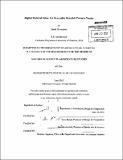| dc.contributor.advisor | Terry Knight and Neil Gershenfeld. | en_US |
| dc.contributor.author | Hovsepian, Sarah | en_US |
| dc.contributor.other | Massachusetts Institute of Technology. Dept. of Architecture. | en_US |
| dc.date.accessioned | 2012-09-13T18:52:40Z | |
| dc.date.available | 2012-09-13T18:52:40Z | |
| dc.date.copyright | 2012 | en_US |
| dc.date.issued | 2012 | en_US |
| dc.identifier.uri | http://hdl.handle.net/1721.1/72807 | |
| dc.description | Thesis (S.M.)--Massachusetts Institute of Technology, Dept. of Architecture, 2012. | en_US |
| dc.description | Cataloged from PDF version of thesis. | en_US |
| dc.description | Includes bibliographical references (p. 50-51). | en_US |
| dc.description.abstract | Spacecraft missions have traditionally sacrificed fully functional hardware and entire vehicles to achieve mission objectives. Propellant tanks are typically jettisoned at different stages in a spacecraft mission and left to burn in the atmosphere after one use, creating a substantial amount of waste and redundancy which leads to high operational costs. Spaceflight programs cannot continue to rely on current methods of discarding hardware, since the cost to transport materials from Earth is extremely high. Significant improvements need to be made in recovery and reuse of valuable hardware, to be able to lower costs per mission and increase the number of missions. Strategies need to focus on avoiding complete loss of hardware. This thesis proposes a new class of materials called digital material skins, that will revolutionize the fabrication and assembly of everyday functional objects to spacecraft structural applications, by embedding the intelligence not in the fabrication tools but in the materials themselves, to create reusable and recyclable materials. A workflow for digital material skins is also demonstrated, based on existing fabrication tools to rethink the entire lifecycle of functional skins from design to fabrication to disassembly. When a child builds a structure out of Legos, precision lies not in the human assembler but in the material, component geometry, and linking mechanism to dictate how and where each material interlocks within the larger material system. A digital material skin is made of discrete units with a finite set of parts and joints used to construct a functional structural skin for airtight,waterproof, high or low pressure applications.The surface is enclosed or the surface is open. Digital material skins are used to construct any shape or interior volume that is regular or amorphous. A digital material skin is an exterior structure which relies on an interior digital material structure for support, or a digital material skin is self-supported with few or no interior support. Parts and links are arranged and configured in a regular pattern to create a surface larger than the units themselves. The skin is part of a larger assembly or part of a single unitary structure of any size or shape. The skin may have a thickness that is smaller or larger than any dimension. The skin is made of one or more layers of one material or multi-material units. The joints are reversible, allowing transfer of forces from one unit to adjacent units to create a continuous bulk material. The work will develop a prototype of a digital material skin concept for pressure vessel skins, and adumbrate a new design methodology that considers the entire lifecycle of digital material skins. | en_US |
| dc.description.statementofresponsibility | by Sarah Hovsepian. | en_US |
| dc.format.extent | 51 p. | en_US |
| dc.language.iso | eng | en_US |
| dc.publisher | Massachusetts Institute of Technology | en_US |
| dc.rights | M.I.T. theses are protected by
copyright. They may be viewed from this source for any purpose, but
reproduction or distribution in any format is prohibited without written
permission. See provided URL for inquiries about permission. | en_US |
| dc.rights.uri | http://dspace.mit.edu/handle/1721.1/7582 | en_US |
| dc.subject | Architecture. | en_US |
| dc.title | Digital material skins : for reversible reusable pressure vessels | en_US |
| dc.type | Thesis | en_US |
| dc.description.degree | S.M. | en_US |
| dc.contributor.department | Massachusetts Institute of Technology. Department of Architecture | |
| dc.identifier.oclc | 805985536 | en_US |
